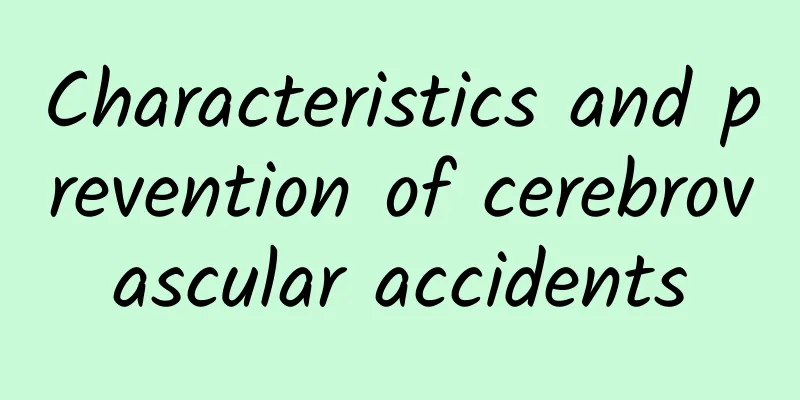Characteristics and prevention of cerebrovascular accidents

|
Blood vessels are the blood vessels of the human body. If blood vessels are blocked, blood cannot flow smoothly, which may cause various discomforts at the least and endanger life at the worst. Winter is also the season with a high incidence of cardiovascular and cerebrovascular diseases. It is very important to do a good job of prevention and health care in daily life. Today, let's talk about the topic of blood vessel maintenance. No.1 There are 10 warning signs for cerebral thrombosis Cerebral thrombosis is caused by atherosclerosis, endarteritis and high blood viscosity, which lead to local thrombosis in cerebral blood vessels. Atherosclerosis is the number one cause of cerebral thrombosis. Since it is more common in the elderly, the incidence of cerebral thrombosis will increase with age. There are 10 warning signs that you must be careful of when cerebral thrombosis occurs. 1. Mouth and eyes are crooked or drooling; for example, one side of the face is weak or numb, the mouth is crooked when smiling, or the mouth cannot hold water when brushing teeth, or even drooling. 2. Hemiplegia, which can be divided into upper limb weakness and lower limb weakness. The symptoms of upper limb weakness include suddenly feeling weak in the arm when shaving with a razor, causing the razor to fall to the ground; being unable to use chopsticks to pick up food smoothly; being unable to button up clothes, etc. Weakness in the lower limbs can manifest as leaning to one side, "running off the side", or even "dragging the legs" when walking; unsteady walking, abnormal gait; and repeated falls when walking, especially when turning the head or looking up. In the above cases, attention should be paid to the possibility of further development into cerebral thrombosis. 3. Inability to speak clearly. It is difficult to speak, the tongue is tangled, or the person cannot understand what others are saying; 4. Blurred vision. Due to occlusion of the artery supplying blood to the eye or damage to the brain center responsible for analyzing vision, the patient may suddenly lose vision in one eye. 5. Sudden dizziness. This is a very common sign of cerebral thrombosis, manifested as dizziness, stuffiness, and even a feeling of dizziness, instability, and loss of control. In severe cases, it may be accompanied by nausea, vomiting, sweating, etc. 6. Limb numbness. Especially numbness on one side of the body is often a warning of cerebral thrombosis; because the brain is not only responsible for limb movement, but also for all sensations, so abnormal sensation is often a sign of cerebral thrombosis. 7. Feeling sleepy, drowsy or yawning frequently; for example, falling asleep while watching your favorite TV shows, having difficulty concentrating, and yawning frequently, etc., indicate that the brain is not getting enough blood to stay awake, and the arteries may be narrowed or even blocked. 8. Headache. Unexplained headache or change in the nature of the original headache, often manifested as persistent pain, and in severe cases, accompanied by nausea and vomiting; 9. Choking and difficulty swallowing. Choking and coughing when eating or drinking, or even difficulty swallowing, may be accompanied by unclear speech and hoarseness; 10. Sudden memory loss and difficulty reading and writing. Some patients suddenly cannot name people or things, cannot calculate or write normally, or often forget things. This indicates that there is something wrong with the cerebral cortex responsible for high-level thinking. No.2 Seven types of people whose blood vessels are most likely to be blocked 1. Obese people: body mass index exceeds 28; 2. People with irregular lifestyle and improper diet: those who like to eat high-calorie, high-cholesterol, high-saturated fatty acid foods, those who exercise little and sit for a long time; 3. Those who smoke, drink alcohol or have a family history of hyperlipidemia; 4. Patients with hypertension and diabetes; 5. Those with a family history of coronary heart disease or atherosclerosis, especially those with early onset or early death in their immediate family members: those with coronary heart disease, cerebrovascular disease or peripheral atherosclerosis; 6. Men over 40 years old and postmenopausal women; 7. Elderly people aged 80 and above. No.3 Eating right can also clear blood vessels Fresh vegetables. Plant-based foods are rich in vitamins, minerals, and dietary fiber, all of which are good for heart health. Asparagus, bell peppers, and bok choy contain a lot of B vitamins, especially vitamin B6, which helps lower levels of homocysteine (an amino acid associated with heart disease) and C-reactive protein (a marker of inflammation). Spices. Garlic contains allicin, which can improve cholesterol levels in the body, lower blood pressure and the risk of heart disease; turmeric is rich in curcumin, which helps lower cholesterol, triglycerides and blood sugar; cinnamon can increase blood flow and help restore blood sugar to normal. Fish rich in omega-3 fatty acids. Fish such as sardines, mackerel, salmon and herring are good sources of omega-3 fatty acids, which help reduce inflammation in the body, reduce heart rhythm disorders, and lower triglycerides and blood pressure. Tea. This beverage is rich in flavonoids, which neutralize free radicals in the body. Black, green, and oolong teas can protect against heart disease in a variety of ways, such as blocking dietary cholesterol from being absorbed into the bloodstream, regulating blood sugar, and reducing inflammation. Drink coffee in moderation. Coffee without cream or artificial sweeteners is healthy for most people. Even though it contains caffeine, drinking it in moderation can help lower blood pressure. Foods rich in dietary fiber. Whole grains, oats, and beans are rich in soluble dietary fiber, which can reduce the amount of cholesterol absorbed by the blood. A study published by the American Heart Association pointed out that eating foods high in dietary fiber can help lower blood sugar and cholesterol. Foods containing unsaturated fats. Unsaturated fats found in avocados, olives, and nuts protect the heart and can lower the level of low-density lipoprotein in the blood. |
<<: Popular Science Knowledge about Dizziness
Recommend
How to treat fungal vaginitis
Some female patients suffer from vaginitis due to...
There are many benefits to eating whole grains! Here are the top ten best grains for you!
Cereals are a general term for food crops mainly ...
Breasts will get bigger after abortion
Abortion is a common way to terminate pregnancy i...
Reasons and precautions for leucorrhea with blood during pregnancy
During pregnancy, many pregnant friends often fin...
Precautions for women's winter health care
Women need to protect their bodies well, especial...
Does insomnia during early pregnancy affect the fetus?
Female friends who have successfully become pregn...
What causes persistent vaginal bleeding?
Many women nowadays have some gynecological probl...
Will it be painful for women to have a medical abortion?
Being pregnant is supposed to be a very happy thi...
Girls have acne on their buttocks
Many people have found that in the summer, their ...
Don't bear it when you have hemorrhoids. You can overcome this unspeakable secret.
Hemorrhoids, commonly known as hemorrhoids, are c...
@Dear citizens, please remember these key points about food safety!
Food is the first necessity of the people, and fo...
What to do if you have pain on both sides of your lower abdomen during your period
Every healthy woman will have a menstrual period ...
What to do if your menstruation lasts for 10 days
Menstrual health issues cannot be ignored, of cou...
I feel dizzy from the heat! Is it heat stroke or heat stroke?
As we all know, we can now enjoy a sauna for free...
Female lips pale
White lips without blood are common in TV dramas....









